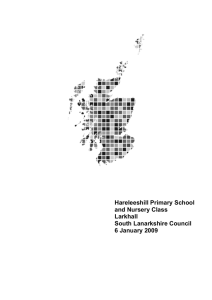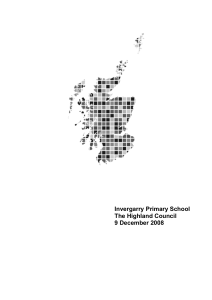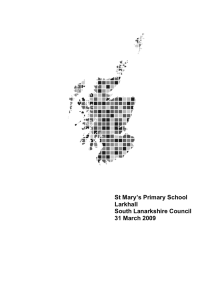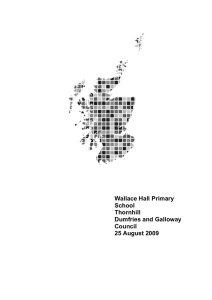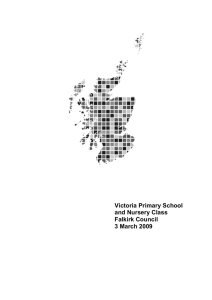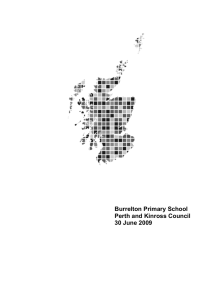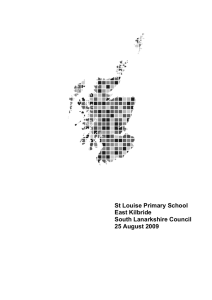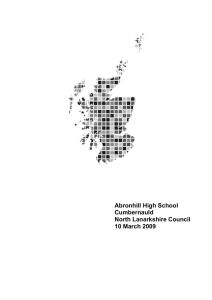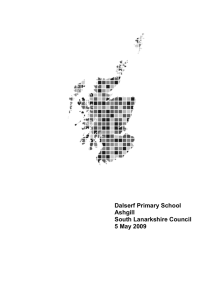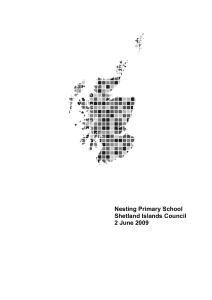Hareleeshill Primary School and Nursery Class Larkhall
advertisement
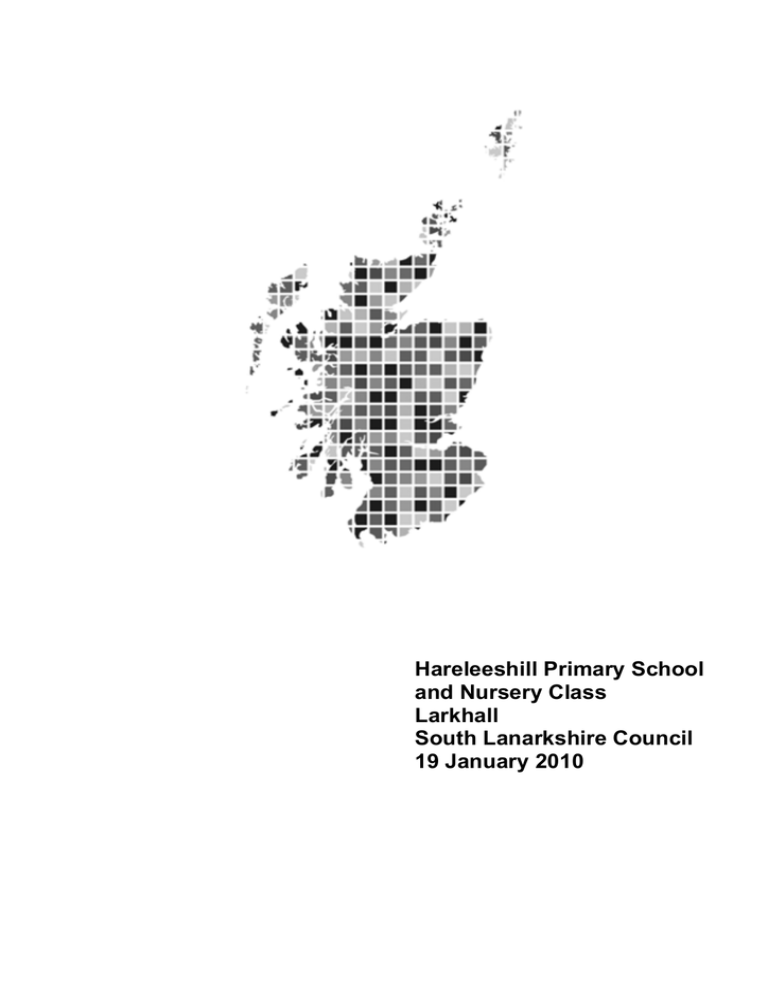
Hareleeshill Primary School and Nursery Class Larkhall South Lanarkshire Council 19 January 2010 We published a report on Hareleeshill Primary School and Nursery Class in January 2008. That report set out key strengths of the school and main points for action. We carried out a follow-through inspection in October 2008 and published a report on that visit in January 2009. This follow-through report is based on an inspection visit which was carried out in September 2009. It tells you about improvements since the original inspection in the quality of education which the school1 provides. It also comments on how the school is getting on with the main points for action. First we focus on changes in the core work of the school. We explain how the school has got better at helping children to learn and benefit from being at the school. Next we look at the key processes which enable this to happen, including the involvement of parents2. Our report also describes developments in the ‘ethos’ of the school, by which we mean how well children are cared for and how much is expected of them in all aspects of school life. Finally we comment on improvements in leadership to help the school achieve its aims. A copy of this report has been placed on the HMIE website www.hmie.gov.uk. Where applicable, you will also find descriptions of good practice in the school and analyses of questionnaire returns. 1 2 The term ‘school’ is used to include the work of the nursery class, where relevant. Throughout this report, the term ‘parents’ should be taken to include foster carers, residential care staff and carers who are relatives or friends. Contents 1. The school 2. Particular strengths of the school 3. How well do children learn and achieve? 4. How well do staff work with others to support children's learning? 5. Are staff and children actively involved in improving their school community? 6. Does the school have high expectations of all children? 7. Does the school have a clear sense of direction? 8. What happens next? 1. The school Hareleeshill Primary School and Nursery Class serves the Hareleeshill area of Larkhall. A new headteacher has led the school since January 2008. A new depute headteacher took up post in May 2008. The school has moved to new accommodation. 1 2. Particular strengths of the school • Courteous, well-behaved children. • Links with parents and the wider community to support learning. • Strong, well-focused leadership from the headteacher and depute headteachers. 3. How well do children learn and achieve? Children are now more actively involved in learning activities. They enjoy working in groups, learning from each other and helping each other. They work well individually. Children are more aware of their own progress and are starting to identify what they need to do next to improve their work further. They are proud of their achievements. Children from the support classes are now involved appropriately in mainstream classes. Children’s progress in English language and mathematics is improving in some areas. Most children in the early and middle stages attain national levels of attainment. However, too few children are attaining appropriate national levels in English language and mathematics at P7. Teachers are using new approaches which are improving how children learn to read and write. In mathematics, teachers rely less on text books and make more use of real situations to develop children’s mathematical skills. School staff are improving aspects of the curriculum so that children’s skills develop at a more appropriate rate as they move through the school. Children in P1 and P2 now learn successfully through play and are active and fully engaged in learning. Teachers now use information and communications technology resources more effectively to support and motivate children. Staff promote equality 2 and celebrate different faiths and cultures. Teachers now plan better across a wider range of subjects. They are now using assessment more effectively to provide tasks in class that better meet the needs of all children. Children who need extra support in their learning now have appropriate plans in place to support their learning. 4. How well do staff work with others to support children's learning? Staff work well with the headteacher to further improve children’s learning experiences. There are good links with the home-school partnership worker to provide workshops for parents to help them become involved in their children’s learning. The school has positive links with the Active Schools coordinator, and with parents, who provide a wide range of after-school activities. 5. Are staff and children actively involved in improving their school community? A large number of children are members of school committees, such as the pupil council, where they can offer opinions on how to improve their school experiences. Parents, children and members of the local community have worked together to improve the school grounds. The headteacher is improving the way in which the school monitors its work. All parents, children and staff are now involved in reviewing the quality of the school’s provision. The headteacher and staff now track children’s progress more effectively. 6. Does the school have high expectations of all children? Almost all staff have higher expectations of children’s attainment and achievement. They now share these expectations clearly with children. Teachers now take good account of children’s prior learning to provide them with suitably challenging activities. Children are 3 responding well and their progress in English language and mathematics at most stages is improving. Children are now becoming more involved in their learning and in setting targets for improvement. 7. Does the school have a clear sense of direction? The school is making effective progress. The headteacher has a clear vision for the school and is aware of the school’s strengths and areas for improvement. She works very well with staff and parents and has the respect of the children. She is well supported by the two depute headteachers who carry out their remits well. Hareleeshill Primary School now shows a strong capacity to improve. 8. What happens next? Since the original inspection, there is clear evidence of improvement. Overall, the school performs better. The curriculum, learners’ experiences and achievements, and self-evaluation are now at a satisfactory or better level. With continued effective leadership the school is well placed to improve further. We will make no further visits in connection with the January 2008 inspection report. The District Inspector will continue to engage with the education authority to monitor progress in improving aspects of attainment. HM Inspector: Sadie Cushley 19 January 2010 4 To find out more about inspections or get an electronic copy of this report go to www.hmie.gov.uk. Please contact the Business Management and Communications Team (BMCT) if you wish to enquire about our arrangements for translated or other appropriate versions. If you wish to comment about any of our inspections, contact us at HMIEenquiries@hmie.gsi.gov.uk or alternatively you should write in the first instance to BMCT, HM Inspectorate of Education, Denholm House, Almondvale Business Park, Almondvale Way, Livingston EH54 6GA. Our complaints procedure is available from our website www.hmie.gov.uk or alternatively you can write to our Complaints Manager, at the address above or by telephoning 01506 600259. If you are not satisfied with the action we have taken at the end of our complaints procedure, you can raise your complaint with the Scottish Public Services Ombudsman (SPSO). The SPSO is fully independent and has powers to investigate complaints about Government departments and agencies. You should write to the SPSO, Freepost EH641, Edinburgh EH3 0BR. You can also telephone 0800 377 7330, fax 0800 377 7331 or e-mail: ask@spso.org.uk. More information about the Ombudsman’s office can be obtained from the website at www.spso.org.uk. Crown Copyright 2010 HM Inspectorate of Education
